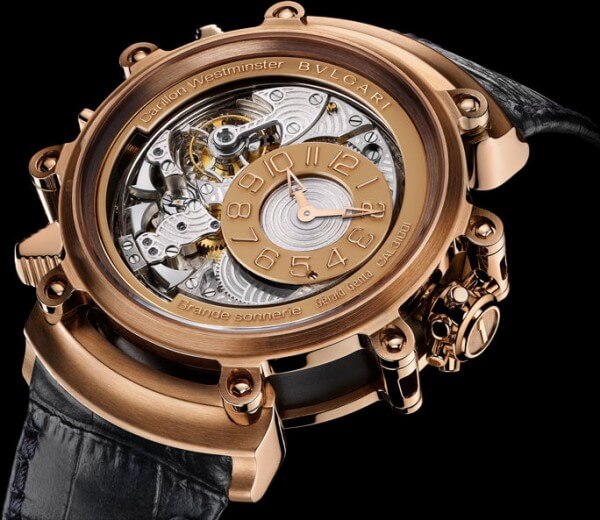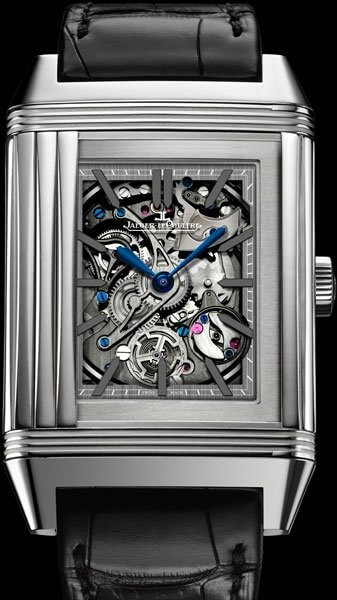Of all the complications that can be built into a watch, the minute repeater might be the least useful in the modern world, but is no doubt the most charming and represents the epitome of high watchmaking. Invented in the 18th century before electric lighting illuminated dark parlors, the minute repeater enabled people to know the time at night, sounding out the hours, quarter-hours and minutes by means of hammers hitting bells or gongs.
We obviously don’t have a particular need for striking watches, but brands continue to make them because like the tourbillon, whose usefulness in improving timekeeping is questionable, it provides a platform to demonstrate skill and creativity.
The Millenary Hand-Wound Minute Repeater by Audemars Piguet
As far back as its founding in 1875, Audemars Piguet constructed minute repeater and Grande Sonnerie models. For 2011 the brand explores the complication in the Millenary Hand-Wound Minute Repeater. This new Calibre 2910 incorporates the proprietary AP escapement, which is based upon the Robin escapement from the 18th century. This design reduces energy losses and eliminates the need for lubrication in the pallet stones, making for enhanced accuracy and stability. Audemars Piguet also used two balance springs in opposition to compensate for poising flaws as well as cancel out errors due to gravity.
Providing a seven-day power reserve are two barrels, with the addition of a third dedicated to the striking mechanism. The third barrel is two and a half times larger than normal and built to enhance the regularity of the notes. For its favorable resonance qualities, titanium was chosen for the oval-shaped case.
The Bulgari Magsonic Grande Sonnerie Tourbillon
Tuning a minute repeater for optimized tone and sound has traditionally been a subjective exercise, trusted to the hands and ears of acknowledged masters. The Bulgari Magsonic Grande Sonnerie Tourbillon from the Gérald Genta Collection seeks to quantify the purity and quality of sound using 21st century tools. In conjunction with an acoustic laboratory, Gérald Genta developed an exclusive software program to measure sounds produced in its Grande Sonnerie watches based on the criteria of intensity, harmony and cadence. Though still requiring a highly skilled watchmaker to fine-tune the watch, now there are benchmarks established to reach a measurable and acceptable result.
Like the name implies, the watch incorporates a tourbillon into the already complex Grande Sonnerie mechanism, which rings out the time with Westminster chimes. While the company remains mum about the alloy composition of the case, they reveal that tests show titanium and white gold perform better than stainless steel for sound quality. In pursuit of better volume, Bulgari explains that they have repositioned the gongs from the movement and fixed them to the case.

The Reverso Repetition Minutes à Rideau by Jaeger-LeCoultre
For the 80th birthday of the Reverso, Jaeger-LeCoultre paid tribute by releasing several new models, including the Reverso Repetition Minutes à Rideau, which is the second minute repeating Reverso in history. The watch is referred to as Rideau, which means blind, because 16 white gold slats hide the dial from view. With the slide of a finger, the curtain pulls back to reveal the minute repeating mechanism through the sapphire crystal while also activating its sounding of the time. Not only does the curtain provide a functional purpose, it also contributes to the aesthetics, giving the option of four different faces on view.
To create a pure and melodious tone, Jaeger-LeCoultre developed a new type of gong, which is composed of a special alloy fabricated in one piece in a square shape. Usually gongs are round, but in this case a square design was chosen to provide a larger contact surface for the hammer, which can strike with increased force.

The Réveil Musical by Breguet
In their history, Breguet has many of examples of minute repeaters. Seeking to extend the horologic aural experience, they introduced the Réveil Musical, a watch that plays a tune on command through the pressing of a push piece located at 10 o’clock or sounds as an alarm for a pre-set time. Replacing the hammers and gongs is a disc carrying pins that act on 15 metal teeth of a comb, much like a music box. A metallic glass membrane amplifies the frequencies, while openings drilled in the case ensure the transmission of sound.
During the tune, which takes 20 to 25 seconds to complete, the dial does a pirouette, adding a further element of animation. To ensure the tune plays in its entirety, Breguet built in a system, displayed at 3 o’clock, to prevent the dial from starting its rotation if there isn’t sufficient power reserve.
While we don’t have a particular need for the musical watch in contemporary society—baring an extended blackout—the complication delights not only for its artistic complexity but also for its ability to engage time with both sight and sound.













